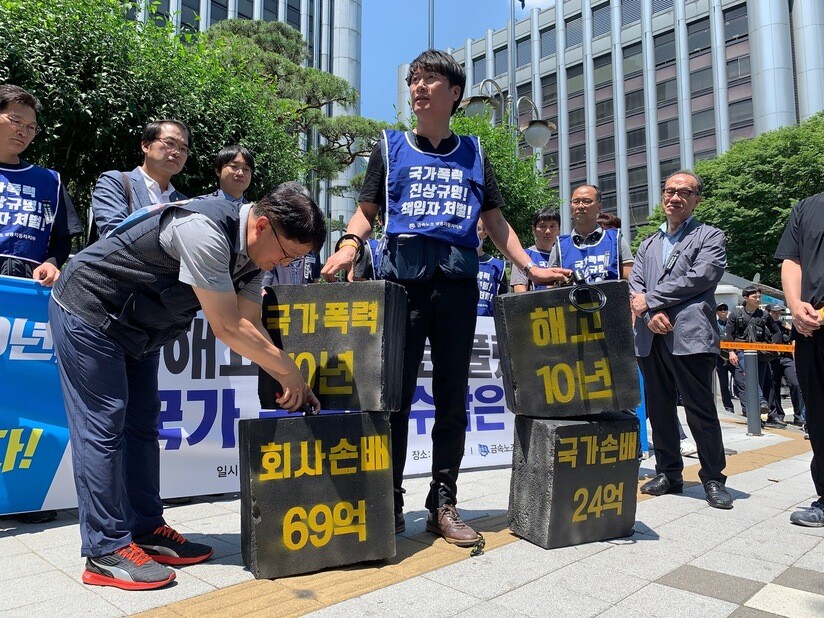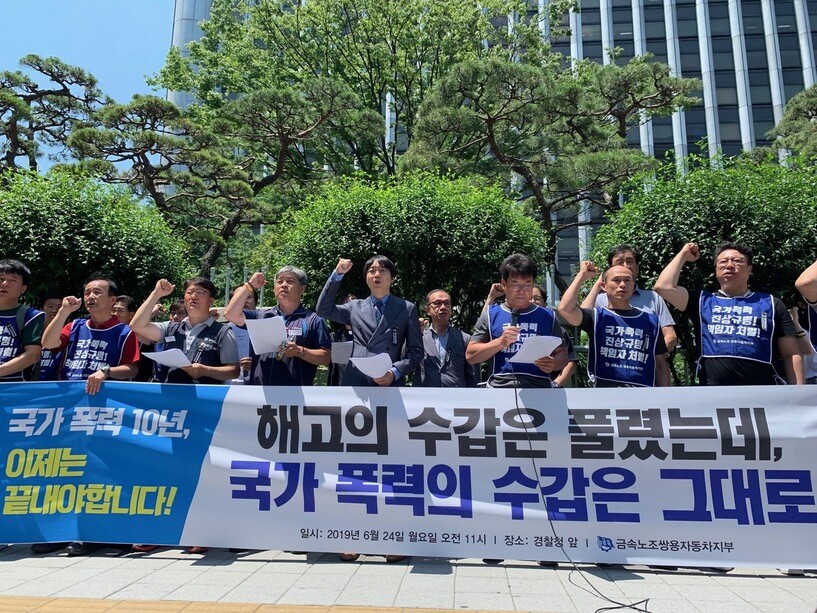hankyoreh
Links to other country sites 다른 나라 사이트 링크
SsangYong Motor workers reinstated by still face state lawsuits

“After 10 years of battling, I received a text from the company.”
Kim Deuk-jung, leader of the SsangYong chapter of the Korean Metal Workers’ Union (KMWU) posted a Facebook message on June 20 that included a screen shot of a text containing a “physical examination schedule for SsangYong Motor technical positions.” The following day, Kim reported a fellow reinstated SsangYong worker who was receiving a checkup as saying, “It [the reinstatement] finally feels real.” But while they were returning to the company 10 years after being dismissed, they weren’t entirely happy. Although they have been reinstated, lawsuits from the state and company demanding damages have yet to be resolved.
Of the 119 SsangYong Motor workers dismissed from the factory in 2009 amid large-scale layoffs, Kim and 47 others previously unable to return to the company are being reinstated as of July 1. An initial group of 71 workers was reinstated on Dec. 21 of last year. In a labor-management agreement mediated on Sept. 14 by the Economic, Social and Labor Council (ESLC), the KMWU SsangYong chapter, SsangYong labor union, and SsangYong reached an agreement in which 60% of the 119 dismissed workers to be reinstated would be hired by the end of 2018, while the remainder would be taken on in phases during the first half of 2019.
The shackles of layoffs may have been released, but the workers have been unable to fully return to ordinary life. The 48 workers returning to the job on July 1, Kim included, have only been given company badges to wear around their necks – with no actual line assignment. It’s a form of unpaid reinstatement.
“Even after labor and management agreed to reinstate all of them, so far it’s been selective reinstatement. The company brought back the first group of 71 as of Dec. 31 of last year and told the other layoff victims to wait,” said Yoon Ji-seon of the group Sonjabgo.
“The union has demanded that they keep their promise to reinstate everyone within the given time frame, and in return [the company] took a step back and said they would reinstate their positions first, albeit unpaid,” she explained.
“The idea is that we could wait in hope once we have company IDs to hang around our necks.”
An even tougher constraint on SsangYong workers than the layoff shackles has been a lawsuit by the state seizing their possessions for damages. In 2009, police filed suit against members of the SsangYong chapter of KMWU to demand compensation for a helicopter and crane damaged when officers were sent to quash a strike. In the first trial in 2013, the court ordered the payment of 1.41 billion won (US$1.22 million) in compensation; the second trial court ordered payment of 1.17 billion won (US$1.01 million) in 2015. With delay charges factored in, the total amount of compensation is 2.5 billion won (US$2.16 million). The case is currently pending in the Supreme Court.

State seizes wages, severance pay, and real estate of union members
SsangYong union members have had their wages, severance pay, and real estate seized following the state’s request for damages. Attachments were lifted for 26 reinstated workers by the Ministry of Justice on Feb. 1, 2019, but according to data shared by KMWU’s SsangYong chapter, they remain in place for 14 workers who have been reinstated or resigned voluntarily. Another lawsuit by SsangYong claiming damages for losses due to the union’s strike is still in its second trial. In 2013, the court in the first trial ruled for KMWU to pay around 7.6 billion won (US$6.57 million), including 20% annually in delay charges.
“The layoff shackles have been released, but the shackles of state violence remain,” the SsangYong chapter said in a June 24 press conference before the National Police Agency in Seoul’s Seodaemun district.
“The lawsuits demanding damages must be withdrawn immediately,” the chapter insisted.
During the press conference that day, attorney Jang Seok-woo asked, “Can the state demand damages for workers exercising their constitutionally stipulated freedom of assembly and demonstration and the three basic labor rights?”
“Most of the damages concerned the helicopter and crane, but was it really a suitable exercise of authority to bring in a helicopter and crane to suppress a strike?” Jang asked.
“An NPA fact-finding committee concluded last year that this was an unlawful use of public authority in violation of the proportionality principle,” he noted.
“If there was damage, then the compensation should be by the police who brought all of this equipment in the first place, not the workers,” Jang continued. In August of last year, an NPA committee investigating human rights infringements announced the results of its examination of the SsangYong Motor incident, in which it urged the police and administration to “apologize for the excessive exercise of public authority, withdraw related lawsuits claiming damages and compensation, and apologize.”
Chae Hee-guk, 48, is one of the SsangYong workers still subject to a provisional attachment.
“On Apr. 3, I spoke in front of the National Human Rights Commission of Korea about the difficulties my family and I have experienced since 2009 as a result of the attachment,” he said.
“But there’s been no change from the police. My family and I desperately want to escape the invisible bars of this prison of attachments that remains 10 years later,” he added. “I hope that feeling of desperation reaches the National Police Agency and this problem can be resolved.”
The workers announced plans to begin holding one-person demonstrations in front of the NPA for one hour every weekday beginning on June 24 to demand punishment of those responsible for state violence and the withdrawal of the lawsuits.
By Yi Ju-been, staff reporter
Please direct comments or questions to [english@hani.co.kr]

Editorial・opinion
![[Column] Season 2 of special prosecutor probe may be coming to Korea soon [Column] Season 2 of special prosecutor probe may be coming to Korea soon](https://flexible.img.hani.co.kr/flexible/normal/500/300/imgdb/original/2024/0426/3317141030699447.jpg) [Column] Season 2 of special prosecutor probe may be coming to Korea soon
[Column] Season 2 of special prosecutor probe may be coming to Korea soon![[Column] Park Geun-hye déjà vu in Yoon Suk-yeol [Column] Park Geun-hye déjà vu in Yoon Suk-yeol](https://flexible.img.hani.co.kr/flexible/normal/500/300/imgdb/original/2024/0424/651713945113788.jpg) [Column] Park Geun-hye déjà vu in Yoon Suk-yeol
[Column] Park Geun-hye déjà vu in Yoon Suk-yeol- [Editorial] New weight of N. Korea’s nuclear threats makes dialogue all the more urgent
- [Guest essay] The real reason Korea’s new right wants to dub Rhee a founding father
- [Column] ‘Choson’: Is it time we start referring to N. Korea in its own terms?
- [Editorial] Japan’s rewriting of history with Korea has gone too far
- [Column] The president’s questionable capacity for dialogue
- [Column] Are chaebol firms just pizza pies for families to divvy up as they please?
- [Column] Has Korea, too, crossed the Rubicon on China?
- [Correspondent’s column] In Japan’s alliance with US, echoes of its past alliances with UK
Most viewed articles
- 1[Column] Season 2 of special prosecutor probe may be coming to Korea soon
- 2No good, very bad game for Korea puts it out of Olympics for first time since 1988
- 3‘We must say no’: Seoul defense chief on Korean, USFK involvement in hypothetical Taiwan crisis
- 4Korea’s 1.3% growth in Q1 signals ‘textbook’ return to growth, says government
- 5Division commander ordered troops to enter raging flood waters before Marine died, survivor says
- 6Is N. Korea threatening to test nukes in response to possible new US-led sanctions body?
- 7Is Japan about to snatch control of Line messenger from Korea’s Naver?
- 8[Editorial] In the year since the Sewol, our national community has drowned
- 9[Editorial] 10 years on, lessons of Sewol tragedy must never be forgotten
- 10[Editorial] New weight of N. Korea’s nuclear threats makes dialogue all the more urgent